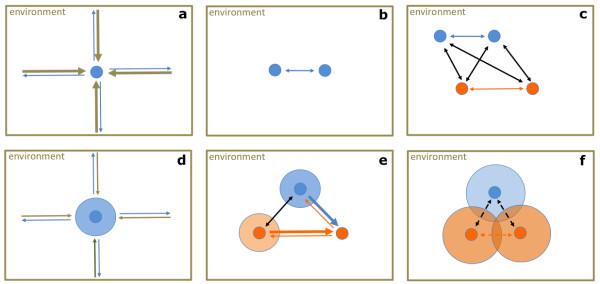Figure 1.
Selection pressure and evolution of social organisms: A) Each individual cell or organism is embedded in an environment, and both impose constant selection pressure in terms of harmful effects on each other (arrows; the width of the arrows corresponds to the strength of the executed selection pressure). B) Non-social individuals of the same generation compete with each other for resources. For reasons of clarity the selection pressure of the environment is not depicted albeit constantly present. C) Non-social individuals of proximate generations (parental, blue; F1, orange) also compete all with each other (inter-individual selection). D) Social individuals can reduce the inter-individual selection pressure by propagating "altruistic genes", and hence can cope better with the environment (see arrows; the circle resembles the colony). E) Colonies of social individuals may drive non-social individuals to go extinct, although they compete with each other (inter-group selection). In social insects, genes engendering cooperation, and specifically the developmental plasticity needed for an efficient division of labor, will be selected because cooperative groups can either outcompete less cooperative groups and/or cooperation allows persistence in otherwise inhospitable environments. F) In addition, individuals and their colonies may cooperate to reduce inter-colony selection pressure, as seen in supercolonies of social insects and in solid tumors composed of thousands of tumor stem cells (TSCs) and their inter-cooperating progeny (depicted as overlapping circles).

